Building of the Month - February 2016


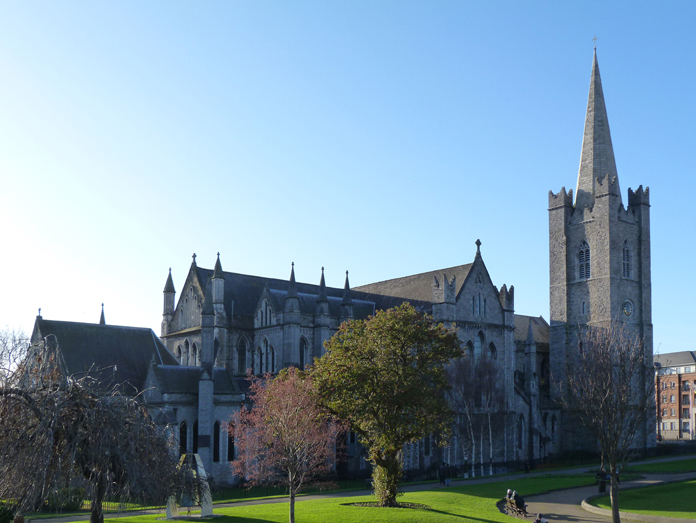
Figure 1: A view of Saint Patrick’s Cathedral, Dublin, from Saint Patrick’s Park. A place of worship has stood on or near this site since the eighth century although the present cathedral can trace its origins back to the early thirteenth century when a wooden church was dismantled and a new stone building erected in its place. The cathedral has survived wars, revolutions, reformations, fire and floods, but has not always escaped unharmed and, combined with the ravages of time, has required restoration several times over the course of its long history including the Guinness Restoration of the 1860s
Saint Patrick’s Cathedral in Dublin is arguably one of the most fascinating pieces of architecture in Ireland. While the story of the site possibly dates back to Saint Patrick himself, the earliest known reference to a church on this site dates from 780AD with a mention of a Saint Patrick’s in insula. This was probably a small wooden church located on an island between two branches of the River Poddle.
The arrival of the Anglo-Normans ushered in changes across the Irish landscape and Saint Patrick’s was no different, with the first Anglo-Norman Archbishop of Dublin, John Comyn, raising its status from that of a small parish church to a collegiate church – that is a church with a larger body of clergy and one that is dedicated to worship and learning. In 1219, Comyn was succeeded by Archbishop Henry of London who elevated the status of Saint Patrick’s to that of a cathedral. Dublin was now in the unusual position of having two medieval Cathedrals, Saint Patrick’s and Christ Church. The reasons for this are unclear, but the fact that Saint Patrick’s was located outside the original city walls may have appealed to the Anglo-Norman bishops.
In around 1220 the old wooden church was taken down and the construction of a new cathedral in stone began. Work on the cathedral lasted for around forty years and was supervised by Archbishop Luke who sadly never saw the finished building as he was blind by the time it was complete. The Lady Chapel was added to the cathedral in 1270. Since its original construction the building has survived wars, revolutions, reformations, fires and floods. However, it has not always escaped unharmed from these events and this, combined with the general passage of time, has resulted in the cathedral needing to be extensively restored several times in its long history.
Each restoration has added a new facet to the building’s continuously developing identity. This generation’s guardians of the building face familiar challenges. They maintain and restore the largest cathedral or church in Ireland using money raised almost exclusively through tourist visits with the daily bill for the upkeep of the building running into the thousands. In 2016 attention turns towards the roof of the building which will be completely replaced in one of the largest projects the cathedral has ever known. It is ironic therefore that this work should fall on the anniversary of the most significant restoration in the Cathedral’s history: the Guinness Restoration (1860-5).
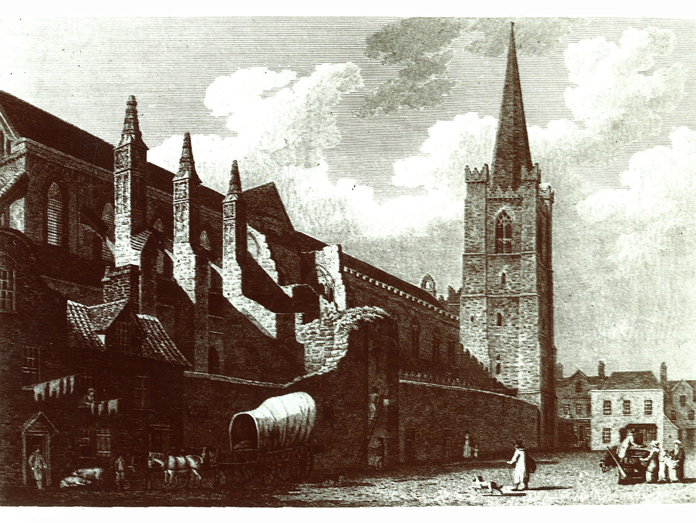
Figure 2: An early nineteenth-century engraving showing a similar view of Saint Patrick’s Cathedral prior to the Guinness Restoration (1860-5). Years of neglect had resulted in the early nineteenth century in a cathedral on the point of ruination and the north transept – known as the Church of St. Nicholas Without – is shown with crumbling walls and without a roof
Saint Patrick’s Cathedral in the early nineteenth century was in a ruinous state as a result of years of neglect. The north transept of the cathedral – which at the time was known as the Church of St. Nicholas Without – was closed due to its dilapidated state. A report, commissioned in 1805, suggested that it would actually be cheaper to simply reconstruct the entire building rather than attempt a restoration. Efforts were made several times to paper over the cracks. Dean Henry Packenham’s (1787-1863) arrival in 1845 gave rise to a new momentum to deal with the enormous structural issues in a wholesale way.
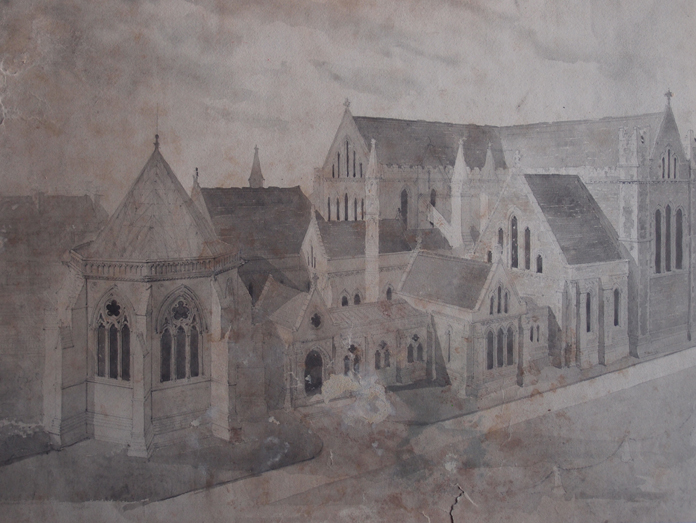
Figure 3: One of a series of drawings exhibited (1846) by Richard Cromwell Carpenter (1812-55) at the Royal Hibernian Academy showing a vision for an entirely refurbished Saint Patrick’s Cathedral. The triple lancet window and crow stepped battlemented piers were realised in the restructured north transept
A series of drawings was commissioned in 1846 and exhibited at the Royal Hibernian Academy. These were executed by English architect Richard Cromwell Carpenter (1812-55) and depicted a vision for an entirely refurbished building. Packenham led a fundraising drive which eventually saw the cathedral receive donations from people such as Queen Victoria. Ironically, despite this show of support from the monarch of the day, insufficient funds were raised to carry out Carpenter’s vision. However, Packenham worked for many years with the limited resources at hand and successfully restored the Lady Chapel of the building between 1844 and 1852.
In 1860 Sir Benjamin Lee Guinness (1798-1868) dramatically entered the story with a sweeping offer. He would personally bear the cost of a full restoration of the cathedral. However, his unusual stipulation, outlined in a letter to the board of the cathedral, was that he wanted to undertake this work only ‘if they are pleased to entrust me unrestrictedly and without interference‘. Guinness took the unusual step of not employing an established architect to oversee the project. This decision caused some controversy amongst the architectural community which was given a platform through The Dublin Builder, a relatively new publication at the time.
 by Canon Ralph Sadlier.jpg)
Figure 4: A photograph (1863) by Canon Ralph Sadleir (1815-1902) showing work underway on the reconstruction of the south transep
The Guinness restoration coincided with the Gothic Revival movement and also a growth in interest in “Ecclesiology”, the study of the functions of church buildings. The Ecclesiological movement advocated updating church building processes to reflect modern liturgical practises. In many ways Guinness steered the restoration in between these two movements. He sought to revive the medieval aesthetic of the building while at the same time modernising it.
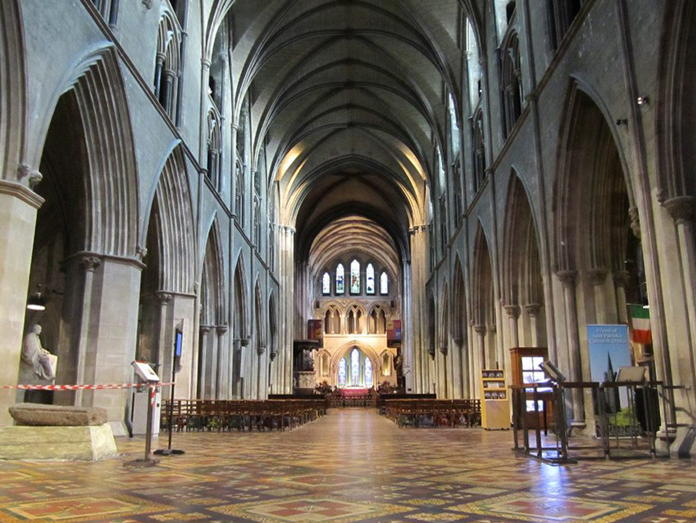
Figure 5: A view of the interior looking through to the choir showing three distinct tiers: the pointed-arch arcade with hood mouldings resting on portrait label stops; the triforium with coupled openings resting on limestone colonettes; and the glazed clerestorey lighting the upper reaches of the nave. One of the alterations carried out during the Guinness Restoration was the raising of the floor level of the nave to meet that of the choir. The new floor was finished with brightly coloured encaustic tiles set in a geometric pattern and featuring medieval motifs such as the Fleur-de-Lys
A lath and plaster ceiling was added to the nave which, from the underside, gives the appearance of stone. The cathedral’s stone vault in that area had fallen down centuries before. The new ceiling matched the existing stone in the choir perfectly, creating a seamless appearance from the ground. The cathedral’s gothic identity was further resurrected through the creation of three tiers – arcade, triforium; and clerestory – where there had previously been only two.
| While resurrecting the old in some instances, Guinness also removed original features of the building. Perhaps the most controversial aspect of the restoration was his decision to remove the partitions within the building. A pulpitum, or choir screen, divided the choir from the nave and was home to the building’s organ. Guinness removed divisions such as these and essentially created an open plan cathedral. This move reflected changing liturgical taste and in many eyes modernised the building. Nothing remains of this pulpitum today but surviving images suggest that it was a beautiful piece of craftsmanship which is seen by some as an unfortunate casualty of the restoration.
The building was closed between 1860 and 1865 and the work was certainly the most comprehensive restoration project undertaken to that point. While Packenham worked tirelessly with the resources at hand, Guinness brought the financial muscle required to save the building from certain ruin. The cost in today’s money would be approximately €20 million. If attempted today it would almost certainly cost more! Figures 6-7: One of a small collection of paintings showing the interior of the cathedral before its restoration including, in the case of the choir, the elaborate pulpitum or choir screen whose removal was not without controversy: Guinness felt that screens were not appropriate to a post Reformation cathedral where clergy and congregation were treated as equals. A recent photograph shows a similar view of the restored choir with its gilded iron gates, Gothic-style collegiate seating, tapestry-covered altar, and five-light window showing Saint Patrick flanked by Saint Columba and Saint Brigid
|
.jpg) |
.jpg)
An eight hundred year old building is, however, never “saved” in the permanent sense. The advent of tourism onsite has created a new lifeline for the building. Today the daily cost of conservation and restoration runs to an average of €5,000 a day. Large projects periodically tackle different parts of the building. In 2004 the spire was repaired and in 2007 the stone work of the tower was repointed and cleaned, while a further major restoration was carried out in the Lady Chapel in 2013. This of course does not include the enormous work carried out in order to protect the building against major threats such as fire.
.jpg)
.jpg)
Figures 8-9: Saint Patrick’s Cathedral has been the subject of many restorations over the course of its eight hundred year history including, in 2013, the restoration of the Lady Chapel and the three-light Packenham Window by William Wailes (1808-81) of Newcastle upon Tyne
On the one hundred and fiftieth anniversary of the Guinness restoration we remember and celebrate the work carried out by that great benefactor, but also take inspiration from his fearless spirit. Once again the cathedral is in need of repair and work will commence in 2016 to replace the entire roof. While preserving and protecting the building in one sense, the Cathedral also needs to look to its vision for the future.
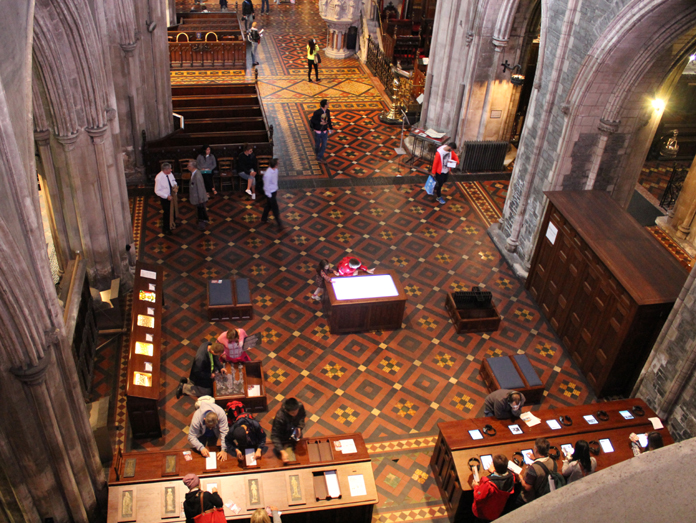
Figure 10: The advent of tourism has created a new lifeline for Saint Patrick’s Cathedral and in 2015 the Discovery Space was launched in the south transept, a vibrant learning environment where visitors have the opportunity to immerse themselves in the history of the cathedral
In 2015 the Discovery Space was launched in the building. This project used wood from recycled pews from the cathedral to create a vibrant learning environment which allows our 500,000 or so annual visitors an opportunity to immerse themselves in the life and history of the building. It marked the beginning of another chapter in the developing identity of Saint Patrick’s Cathedral but one which cherishes the institution’s mission as a place of Christian worship.
.jpg) |
Figure 11: A statue in the south precinct commemorates Sir Benjamin Lee Guinness (1798-1868) who bore the entire cost of the 1860s restoration of Saint Patrick’s Cathedral. The statue by John Henry Foley (1818-74) of Dublin and London stands on a polished pink granite pedestal inscribed on the front: SIR BENJAMIN LEE GUINNESS BARONET LL.D. MEMBER OF PARLIAMENT FOR THE CITY OF DUBLIN; on the left: ST. PATRICK’S CATHEDRAL BY HIM RESTORED A.D. 1865; and on the right: ERECTED BY HIS FELLOW-COUNTRYMEN IN GRATEFUL REMEMBRANCE A.D. 1875
Ciara Ní Cheallacháin and Andrew Smith make up the education department of Saint Patrick’s Cathedral, Dublin, providing educational tours and workshops to schools from all over Ireland as well as developing the overall interpretation of the building and its history for visitors of all ages and from all walks of life Click here to find out more about the history of Saint Patrick’s Cathedral Click here for visitor information for Saint Patrick’s Cathedral Click here for information on daily services at Saint Patrick’s Cathedral |